From Issue 4.1 (Fall 2023): Anti-Monuments
Maggie Groat is an artist for our times. Utilizing found and salvaged materials to explore the intersection of utility, ritual, and care, the artist’s interdisciplinary, often site-specific works spanning collage, sculpture, installation, artist books, and public art also ask honest questions about the function and value of art in times of emergency. Rigorously kaleidoscopic, and earthly but ever-portalling, over the years I’ve come to understand her work as a set of inquiries, models, or speculative toolkits (even while the question of what’s being modelled or fixed exactly remains generously open-ended). It is in this way that her works seem to hold within them dreams and anxieties I didn’t even know I had: practical things, surprising things, lessons I find myself learning from and wanting to carry forward. Maggie and I met virtually in early August for a conversation that lasted several hours more than it was meant to — and we’ve been talking ever since. What follows is an edited version of that conversation.
—Jacquelyn Zong-Li Ross
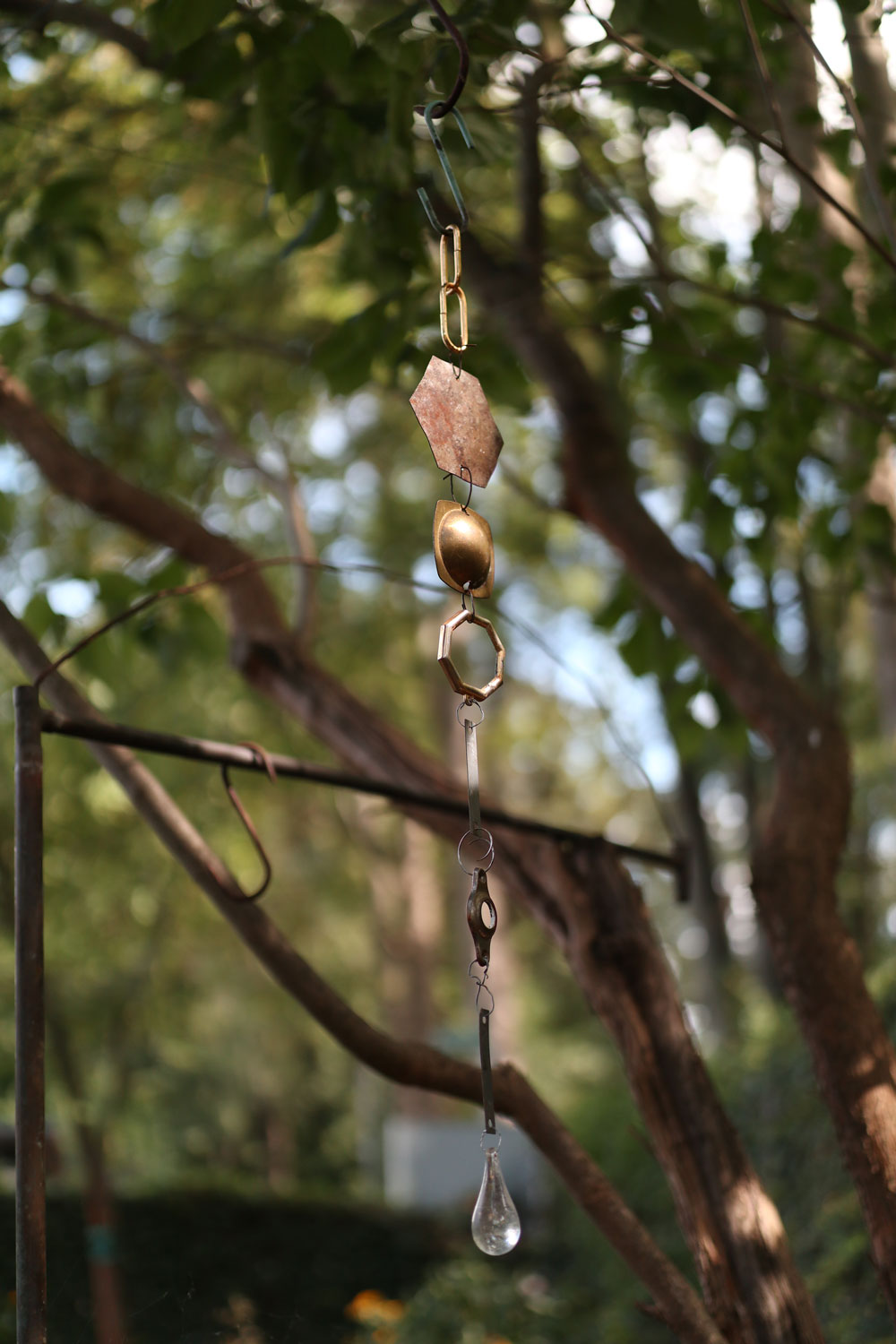
Jacquelyn Zong-Li Ross
I wonder if you could start by telling me about the work you have developed for this issue of The Capilano Review. Where does the title of the project come from?
Maggie Groat
S LOWER F is an anagram of FLOWERS. I like to play with language in my titles: dropping all the vowels, or using coded or cryptic versions of ideas to hide them in plain sight. One day I was trying to make all the words I could think of from the word “flowers” and was thinking about how the words “lower” and “slower” are both hidden within it. In this era of overlapping crisis and anxiety, “SLOWERF” has become my code word for thinking about and enacting slowness and ritual, particularly in relation to the garden. It also orbits things I am thinking about around self-help trends, sleep as protest, and productive forms of escape. These pages are a glimpse into a kind of alternative study I’m developing around these themes.
JZR
I like thinking about the project as a kind of “alternative study.” It seems like a concept that you use quite often in your practice. What is a study, in your mind, and how is it useful? What makes a study “alternative”?
MG
The study is something that has been with me throughout my practice, this idea that practicing is no different from process. For me, the study is an unfixed state. It is an embracing of form that allows for the unfinished, the tangential, the overlapping, the spiralling. It starts with questions, however impossible to answer, followed by honest attempts to move around in them, follow them, enact them. I have used the term “alternative study” in the past to describe both The Lake and ALMANAC, two artist anthologies I edited.1 The Lake (2014) is a mix of selected and commissioned projects by artists, writers, curators, and others that examines the idea of the lake as a body of freshwater, unbound to established fields of scientific or historical study. ALMANAC (2017) worked in a similar way, borrowing the sprawling formal logic of its namesake calendar, but shedding the structure of the annual cycle in favour of more collapsed or non-linear concepts of time. Both came from an interest in producing something that would not sit clearly in any one place or method of inquiry.
JZR
I’ve always appreciated how artistic research coexists with day-to-day life in your work. It seems to me that more and more artists are working this way, highlighting how art-making can also be a mode of living, a mode of coping, a mode of survival.
MG
Natalie Loveless’s book How to Make Art at the End of the World explores the concept of art practice as research-creation: a methodology that, Loveless suggests, “has the capacity to impact our social and material conditions, not by offering more facts, differently figured, but by finding ways, through aesthetic encounters and events, to persuade us to care and to care differently.”2
There’s a different kind of goal in research-creation practices — it’s not, you know, I’m making this, and now it’s done and exhibited, and now it goes into storage. That has never been the way I’ve approached my practice. My practice has always been about intersections of utility — thinking about the tool, or the toolkit — and ritual: something that elevates or determines the tool as being for a particular use. And then of course there is always the aesthetic dimension of the thing, or the way the thing exists materially, and the action that it symbolizes.
For the last couple of years, I have not had a studio space outside of the home. I work seasonally in our sunroom, outdoor spaces, and in our garage-turned-studio. It’s very blurry, where my work exists. Sometimes my kids will pick up some random thing and be like, “Can I use this, or is this for your work?” [Laughs] I’m really interested in this lack of division. In many ways I work this way because I have no other choice. I have had to figure out where art-making can ft in, where it can exist alongside the care responsibilities of having young children. I am also always considering my practice in relation to ecological impact, so have learned to thrive with the constraints of working only with found and existing materials, and figuring out, for me, what’s worth making. I think a lot about the origins of art and its relationship with and dependence on having time to devote to something beyond survival. What happens when you don’t have time to move slowly or discover? How does leisure time fuel creativity, and, conversely, what kind of creative acts stem from immediacy or need? This is largely where my methodologies of working with limitations come from, whether that’s money or space or time. I try to see these not as obstacles, but as contextual fuel.
JZR
Over the years, much of your work has also extended into, or drawn inspiration from, the natural world. Can you tell me more about your interest in the site of the garden?
MG
I do not have an easy relationship with this word, “garden.” “Garden” for me connotes control. In the history of English settler-colonialism, the creation of a garden was seen as a declaration of ownership; it has a strong relationship to the fence, marking the division between what’s “yours” and what’s “mine.”3 When I am shaping the land around the place I live, I am instead thinking things like: How is this space not my own? How does it belong to the other-than-humans that inhabit it, nocturnally or on a microbial level? What is happening underground, beneath my feet? What is on the other side of this fence? I try to think about the garden as a space that I might shape for me, but also not-me, and ways of cultivating that allow for a being with. I am at a linguistic loss in the language I speak to name this relational care-state; I find myself still using the word “garden” all the time, but carrying along within it all these references.
I am interested in what certain choices in cultivated spaces can say about values, aesthetics, and relationships to nature. When we moved into the house we live in now, we inherited the plants that someone had cared for for years. I had to reconcile my responsibility to these beings with my interest in rewilding and working with indigenous-to-Niagara plant species. How to have the forsythia and Japanese maple and lilac co-exist. I think a lot about the concept of of the right plant for the right place, and what shapes the criteria for this. I have learned a lot of lessons from bird gardeners, leaving me gifts like boneset and goldenrod in the perfect, thriving location. Working with, observing, and consuming plants also has me thinking about the collapse of linear experiences of time and how intense sensory experiences can transport you to other times or places.
In 2021, during another stay-at-home summer, I created the performance 13 Minutes in a Garden as part of the virtual program “A Gesture, A Reading: Finding Touch in Occult Practices and Performance Art.”4 For this, I wore a kind of floral “camouflage” that I sewed from custom-printed collage fabric, and the virtual audience was invited to witness the slow act of me being with the garden and doing things like deadheading and weeding to create a ritual compost pile for the seasons ahead. I was interested in visualizing care and the pace of invisible labour at a time when Zoom was creating literal portals everywhere as part of our “new normal.” I continued this project in Berlin the following summer as part of The Future is Dark . . . I Think, a collaboration with Ella Dawn McGeough and Jessica Groome that followed a period in residence in the Schrebergarten of La Datcha.5 Using salvaged materials, I made outdoor installations for collaborations with spiders and worms, and created a twin or mirror garden using North American cultivar pollinator plants that were being sold at the grocers there, and a ritual compost pile that became the residue of caring for this space over the duration of the residency. After I returned home, I projected the livestream “portal” of the garden I care for in Niagara into the garden of La Datcha for the exhibition event. I wanted to create a mirrored space, an access point for the spiders and the worms, to project the sunlight into the darkness of a place six hours ahead, and to think about distance and the ways that it collapses.
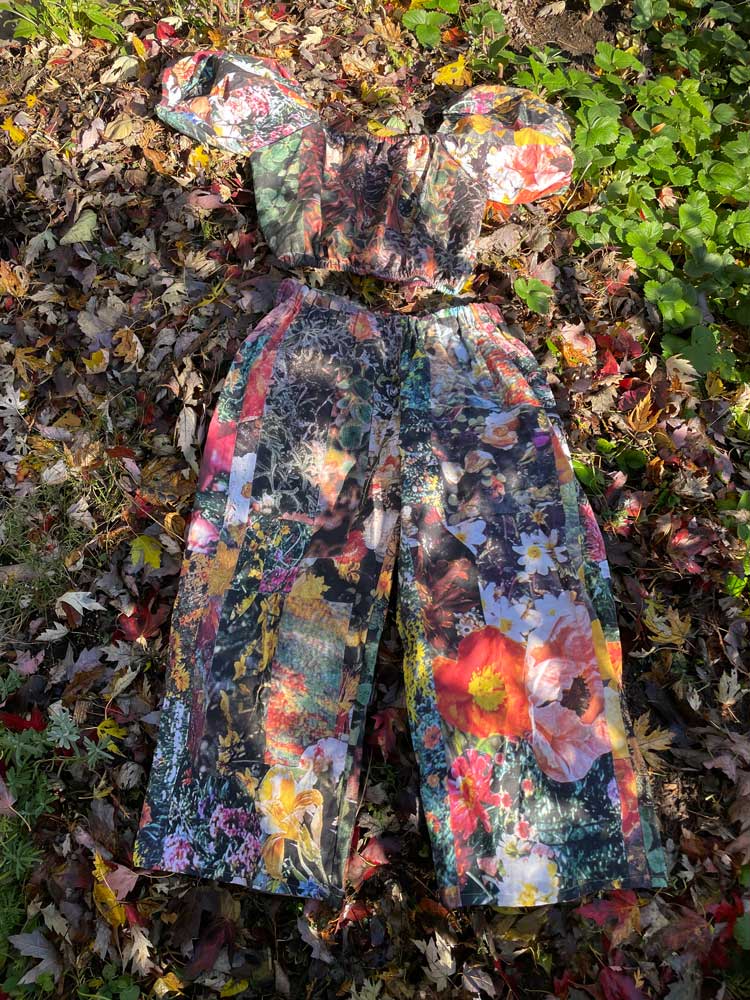
JZR
I’ve always admired the site-responsive nature of your work. Can you talk about how you go about researching and engaging with a site for one of your artworks? I’m thinking in particular about your public artworks — most recently, the DOUBLE PENDULUM billboards installed on the side of that epic warehouse space at Dovercourt & Dupont in Toronto. What does it mean to truly “centre the site” in (public) artwork?
MG
I often begin by looking at the layers of a site and what creates its specifc contextual conditions. I also think about the site in terms of the phenomenological, institutional, and discursive elements that Miwon Kwon discusses in her book One Place After Another.6 I feel a responsibility in my response to place, especially if I am a guest somewhere I do not have a deep connection. In past public works like STSTS at Western Front in Vancouver (2017–2020) or Deep Time, Portals, Particles and Pulls on Armory Street in Toronto (2019–2022), I took on lengthy archival and historical research to inform the creation of the site-response.
For DOUBLE PENDULUM (2023), the project I did with Contact Photography Festival this past spring, I engaged more discursively with the sites. The project existed at three different locations in the city of Toronto — two outdoor sites and a gallery exhibition — and I was thinking about drawing a line between these places, creating a kind of imagined back-and-forth movement between them. The billboards you mention are adjacent to the historical shoreline of the ancient glacial lake, while the three works in Ontario Square are on the human-made land extension that has modified the current shoreline of Lake Ontario and is very close to its waters. I was thinking about the city that has inhabited this lake bed, what and who were here before it, and when or if the water will return. This might not all be visible in the work itself, but these are the things that I was thinking about in deciding what I would make, what would go where. In terms of the images themselves, a collection of five small, handmade collages, each no bigger than eight-by-twelve inches, was digitally enlarged and then wheat-pasted on public billboards in sections. The collages documented intimate encounters that I had had personally and were informed by Edward Lorenz’s concept of the Butterfly Effect,7 as well as by psychedelic visualizations, desktop screensavers, karaoke backgrounds, op art, the way a bee sees flowers, and what happens behind your eyelids when you close your eyes after being in the bright sun . . . things like that. I was utilizing strategies of image doubling, asymmetrical symmetry, figure-ground confusion, visual spiralling or blurring, being out of focus.
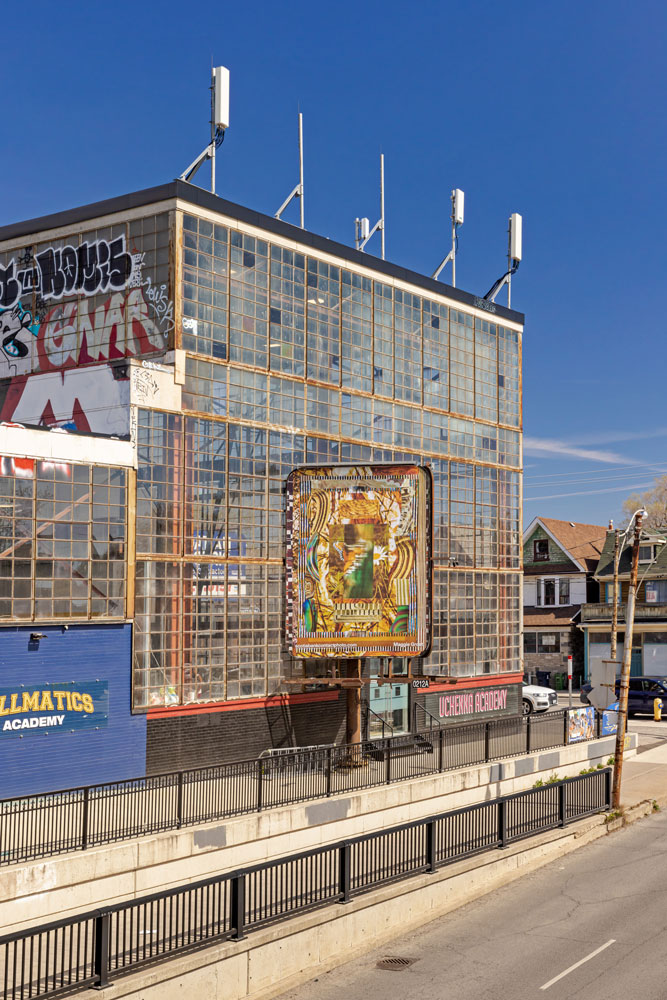
JZR
You described your collage process to me in our recent email exchange as “manual image-making with a data set you create.” I thought this nicely connected the intuitive modes to the more conceptual or analytical modes that I see at play in your work. Could you talk about this further? How do you choose to work with or define your “data”?
MG
This is a recent observation that came out of playing with AI image-creation software like Dall-E 2. I was thinking about how these engines learn from the content of other images in order to make new ones, and thinking about this learning in comparison to my own laborious and manual approach to collage. The piles of images, the recall needed to find that thing I saw an hour ago, the logic of how I find or make order, the additive and subtractive shifting of that physical archive . . . It’s a kind of data set that shifts in the making. Even though I utilize fragments of existing images, I am looking for a collapse in that familiarity.
JZR
What other qualities or characteristics are you looking for in an image?
MG
That’s a really hard question to answer. I think earlier in my career I hesitated to talk about intuition, but there’s definitely an intuitive element to it. I am interested in overlap. I am interested in coincidences, or twins, or things that appear as inverses of each other, or shadows, or things that perfectly line up but which I know have never seen each other before. It’s these moments of making that really surprise me. Working in collage allows for collaboration with the material. Yes, I’m making a lot of decisions, and I have impulses or modes that I return to; it can be easy to slip back into a taxonomical configuration, for example, or to rely heavily on symmetry in cases where there’s a certain gravitational pull toward composition. But there’s something about the material that feels continually inventive. Like, “Oh, I’ve never quite made an image like that before . . . ” I can go through my practice over the past years and follow my shifting research interests in the kinds of images I am collecting. Most recently, I’ve been really drawn towards crafting books from the ’60s and ’70s. There’s a real aesthetic and colour connection between them, as well as images that are fragments in and of themselves, references to knotting and patchwork, which I then cut into and fragment even further.
JZR
How do these methods and ways of thinking about found materials extend into your work in sculpture and installation?
MG
When I work with three-dimensional materials, the things I collect and gravitate towards — similar to an image — are ones whose original purpose or use-value feels ambiguous. My working with it, then, is a further abstraction of its function, a reconfiguration. My most recent sculptures are made from things that once existed in gardens and have also been weathered, somehow . . . the garden fencing that ended up in the street, that then a car ran over, that I then bent back into shape; the thing that had vegetables growing on it all season, and then gets collapsed or stored for next season. I am also drawn to the use of gravity in these assemblages: considering how things can be fit together or balanced without the need for screws or glue. When two random things fit together in such a way as to appear as if they have always been, it’s a kind of material coincidence.
There are lots of history lessons swirling around in my head when working sculpturally, some intentional, some inevitable. There is a long shadow of minimalism, conceptualism, and colour field painting cast on my aesthetics, as well as a preoccupation with pre-modernist female abstractionists like Emma Kunz or Hilma af Klint, attempting to make visible the invisible. In an installation called FIIIPC at the Art Gallery of York University in 2017, I used carpet samples from the local Restore, deadstock wallpaper, and leftover paint from previous exhibitions at the institution to transform the materials into muted murals.
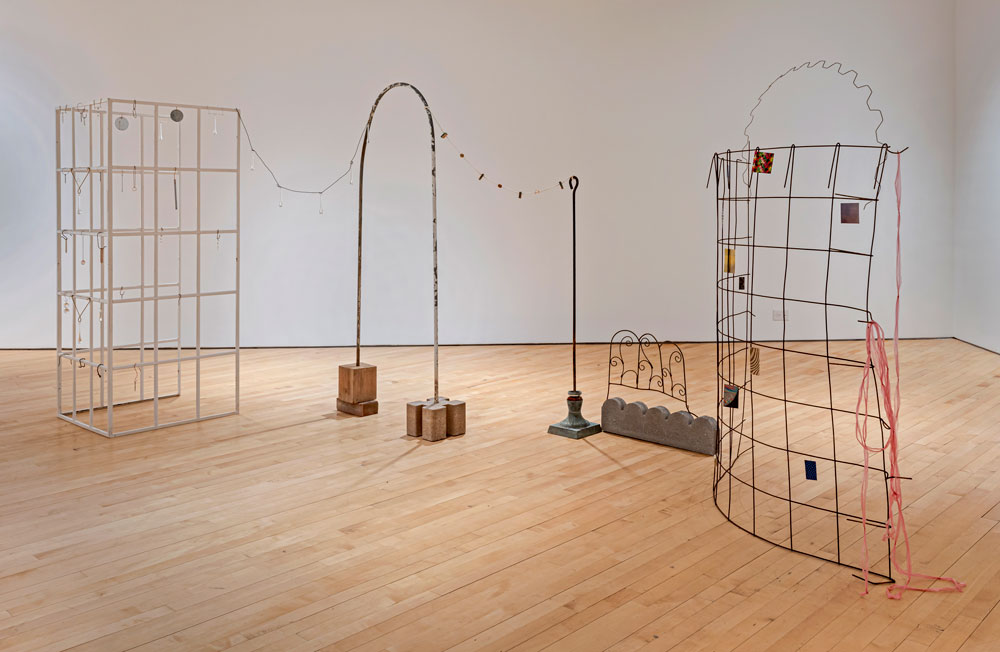
JZR
I’m interested in the way these works collapse time and place. There are other ways that you achieve this, some of which are quite funny. I’m thinking, for instance, of the page of S LOWER F where you query “where to find two-billion-year-old algae close to me” alongside the somewhat more desperate “sensory deprivation tank near me DIY sensory deprivation tank bathtub DIY sensory deprivation” . . . I’m assuming these are Google searches . . .
MG
Yeah. I was thinking about the internet search, but also other methods of searching. Like, what if you were to just ask your neighbour?
JZR
[Laughs] Right.
MG
Or what if you went to the hardware store because you really were trying to make a DIY sensory deprivation tank . . . The text is meant as a purposeful read on online searching, as well as a call for offline searching. If there is something one didn’t acquire intergenerationally or through formal education, away from the internet, how can one still go about searching for it? So yes, I hope it has that kind of dual reading, of being both of the midnight Google search and the impossible immediacy of the outcome of that search. At the same time, there is this earnest question of, “Tell me how to do it! Someone help!”
JZR
There’s something provocative about these kinds of prompts. How do you approach the speculative in your work? Do you think of your work as utopian?
MG
It’s definitely an interest I have in my reading and writing and thinking: how we move from present to future, what we might need to carry with us, what dormant or underground things might need to be revived. I’m very interested in the realm where the impossible becomes possible. There is a utopian impulse to the idea — and I think about this often — of participating in creating the world you’d like to live in, not necessarily the world you do live in. A few years ago, I started playing Minecraft with my kids, inhabiting a collective creative world we made called FLWRMTN. I was trying at the time to encourage my kids to think critically about video games and how to use them, because they were most often playing the game in its intended “survival” mode, which is something totally different and violent and complicated. I was thinking about the possibilities of this virtual space, with its endless resources, as a kind of utopia, a place to world-build. It was fun, but in the end, it was a failed experiment. We quickly realized that even in creative mode it wasn’t the right tool — it was too limited in scope — and we didn’t have a shared vision. Even playing collaboratively began to feel incredibly lonely, each of us of in our own part of the realm. After that I started playing Stardew Valley, and of course Stardew Valley also has its own set of ethical problems within its narrative.8
But I really started thinking about this game as a kind of utopic space: a kind of self-determined space that could be created with intention. There is a central theme of self-sufficiency and homesteading in the game that is an enacting of this romanticized back-to-the-land dream that sits outside of the capitalist frame (at the very beginning of the game, you even leave your office job in the city to farm!) so it felt like a kind of cosplay for me to be able to fulfill some of these deep-seated desires. It mirrored many of the things I was craving in my life at the time: foraging, physical land to grow things on, community . . . The game also mirrors reality in the fact that, when you start, you don’t have any money (I’m not sure if this is social commentary or not, but the way your character has acquired land is only through inheritance). Of course that game is also really problematic because there’s a huge social dimension that feels very . . . Should I have asked you if you’ve played it before?
JZR
Don’t worry, this is all new to me! [Laughs]
MG
I’ve never been able to play Settlers of Catan without thinking about the implications of resource extraction, or about the potential Indigenous population, or about how we are creating imbalances in the ecosystem . . . like why are there so many sheep, you know? I had similarly critical thought paths while playing Stardew Valley, even though it was also allowing for a deep kind of escape to take place. There are particular references in my pages for the Review that connect to some of these ideas — for example, my journal entry about a day played in the world of the game, where I describe what it is that I’m doing and thinking and feeling inside of it. For those that might not be familiar with this reference, it might seem like a really curious way to spend your day. Anyways, a really strange thing happened this past spring, which is I started working at a greenhouse.
I’ve worked at greenhouses before, but this time, right away, I was like, “This is IRL Stardew Valley.” I was hit by this intense confusion between the real and the virtual. It had something to do with the repetitive and meditative banality of watering thousands of pots, deadheading thousands of plants, doing the same thing every day . . . there’s a lot of that in the game. It has taught me some things I really needed to learn about deacceleration, about my relationship to productivity, about the potential of collectivity and collective labour . . . Except, see, now I’m getting confused: Am I talking about the greenhouse, or am I talking about the game? Am I talking about my home life with my kids? There have been a lot of things lately that have become very interestingly overlapped for me.
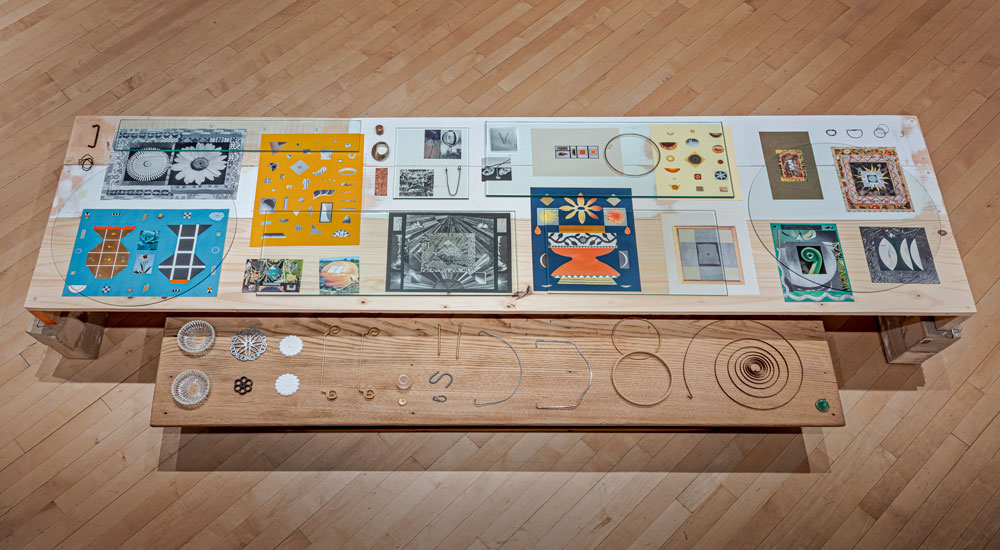
JZR
I thought we could end by returning to some of the ethical questions at the heart of your practice relating to art-making and environmental stewardship. I’m still thinking about Loveless’s prompt about making art at the end of the world. What responsibilities do you feel as a maker in these times?
MG
I find myself constantly asking what is worth making, and why; constantly reevaluating my relationship to what is being produced, and how, and who it is being made for. I feel a responsibility to consider the environmental impact of my practice. It can be challenging to work in, say, the public art realm — choosing to wheat-paste billboards, for example, in order to avoid the use of the industry-default, PVC-based vinyl. It’s also challenging to work with frames, framing – there are certain conventions that I used to use in my practice that I don’t anymore. Or shipping — I used to have rules around only shipping a certain size or weight to exhibitions, but now I’m questioning whether I should be shipping anything at all. And then there are questions like, when do I stop flying? And what about large file sizes and the way that they are housed? I don’t know. It can begin to feel paralyzing. But I am finding myself more able to say, “No, I actually can’t do that project because there isn’t a way for it to be done that aligns with this criteria of material sustainability that I’ve set out for myself.” I know that the examples I just gave take place on an individual level, but it’s my hope that the impact of these refusals, these moments of pushing up against “the way things are done,” might spread. I have noticed when artists choose to work with the content of climate emergency but fail to extend this concern to a work’s materiality. Meanwhile, a project like Plastic Heart by Synthetic Collective considers resources and footprint at every step of the way: the website itself is solar-panel-operated, meaning that if the sun isn’t shining where the server is, it’s down.9
I feel like I need to be a lot more hardlined about the choices I’m making and modelling. Like, maybe I haven’t centred these considerations enough. Maybe I haven’t spoken up enough. Maybe an emphasis on content has somehow overshadowed the attention I give to sustainable methodologies. I would like to talk about this more.
- The Lake (Toronto: Art Metropole, 2014); ALMANAC (Kitchener: Kitchener-Waterloo Art Gallery, 2017). ↩︎
- Natalie Loveless, How to Make Art at the End of the World: A Manifesto for Research-Creation (Durham: Duke University Press, 2019), 106–107. ↩︎
- These ideas are informed by Patrica Seed’s book Ceremonies of Possession: Europe’s Conquest of the New World, 1492–1640 (Cambridge/New York: Cambridge University Press, 1995); see the chapter “Houses, Gardens, and Fences: Signs of English Possession in the New World.” ↩︎
- Curated by Minor Hockey Curatorial in partnership with The Witch Institute at Queens University, “A Gesture, A Reading: Finding Touch in Occult Practices and Performance Art” took place on Zoom on August 21, 2021. ↩︎
- The exhibition The Future is Dark. . . I Think by Maggie Groat, Ella Dawn McGeough, and Jessica Groome was held at La Datcha, Berlin on August 20, 2022 as part of Project Space Festival. ↩︎
- Miwon Kwon, One Place After Another (Cambridge, Mass.: MIT Press, 2004). ↩︎
- In The Essence of Chaos (Seattle: University
of Washington Press, 1995), Lorenz defines the Butterfly Effect as “the phenomenon that a small alteration in the state of a dynamical system will cause subsequent states to differ greatly from the states that would have followed without the alteration.” ↩︎ - The game’s website sets out its premise: “You’ve inherited your grandfather’s old farm plot in Stardew Valley. Armed with hand-me-down tools and a few coins, you set out to begin your new life!” Players are then encouraged to “turn overgrown fields into [a] lively and bountiful farm” and “learn to live off the land: raise animals, go fishing, tend to crops, craft items, or do it all!”
↩︎ - The touring exhibition Plastic Heart: Surface All the Way Through, curated by Synthetic Collective, was held at the University
of Toronto Art Centre from September 8-November 20, 2021. Synthetic Collective’s DIY solar-powered site can be found at https://plasticheart.solar/. ↩︎

